How DP Seamus McGarvey BSC ASC created vivid expressions for 'Bad Times at the El Royale' on Kodak

Jon Hamm stars in Twentieth Century Fox's "Bad Times at the El Royale." Photo by Kimberley French. Copyright: © 2018 Twentieth Century Fox Film Corp
Shot on Kodak 35mm film, Bad Times at the El Royale is considered by some to be among the finest work that cinematographer Seamus McGarvey BSC ASC has accomplished to date.
When questioned about it, McGarvey modestly remarks, “I was thrilled to get the opportunity to shoot Bad Times at the El Royale on film. I am delighted at how it has turned out in terms of working with a director, and from a script, with solid photographic notions of colour and design sensibilities. When those things get written into a production you are off to a really good start cinematographically-speaking. Some projects take a while to coalesce, but when I read the script I could see it…the visuals leapt off the page.”
The 20th Century Fox production, written and directed by Drew Goddard, follows seven strangers, each with a secret to bury, who meet at a run-down hotel in Lake Tahoe during the late 1960s. Over the course of a fateful night, they all get one last shot at redemption until everything goes horribly wrong.
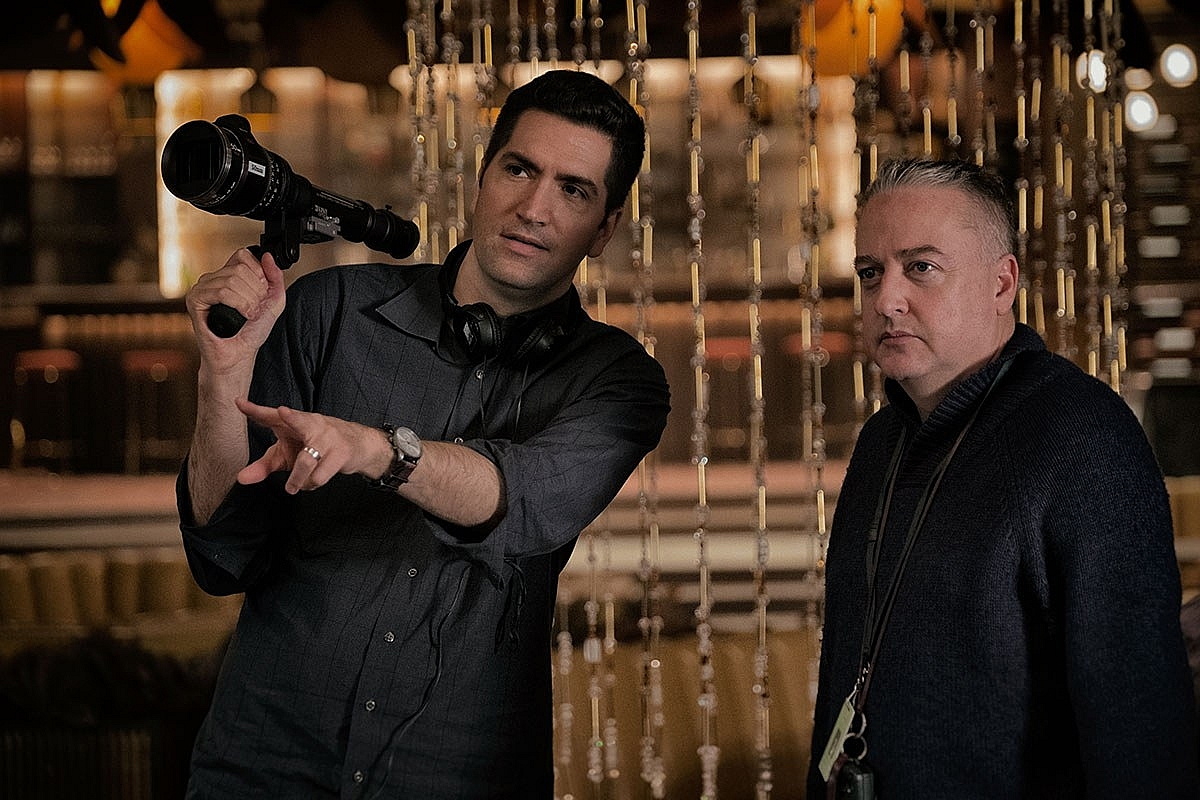
Director Drew Goddard, left, with cinematographer Seamus McGarvey BSC ASC, on the set of Twentieth Century Fox's "Bad Times at the El Royale." Photo by Kimberley French. Copyright: © 2018 Twentieth Century Fox Film Corp.
The vivid, mystery thriller stars Jeff Bridges, Cynthia Erivo, Dakota Johnson, Jon Hamm, Cailee Spaeny, Lewis Pullman, Nick Offerman and Chris Hemsworth, who variously play a priest and a singer, both down-on-their-luck, a vacuum cleaner salesman, a couple of career criminals, a charismatic cult leader and the hotel concierge. The characters are gradually introduced against an ever-foreboding backdrop of rainstorms, with flashbacks alluding to their earlier lives and the events that have lured them to this particular juncture.
Principal photography on the film began at the end of January 2018 at Mammoth Studios in Vancouver, British Columbia. The 50-day shoot in Canada was followed by three additional days in and around Los Angeles. Due to the bitterly-cold climate and inclement winter weather, the hotel set and day/night exteriors, including the hotel parking lot, were constructed immediately adjacent to one another under one roof inside the same studio space. This included a massive rig with rain heads that could be adjusted in terms of intensity, and a 3ft run-off to allow thousands of gallons of water to drain safely away.
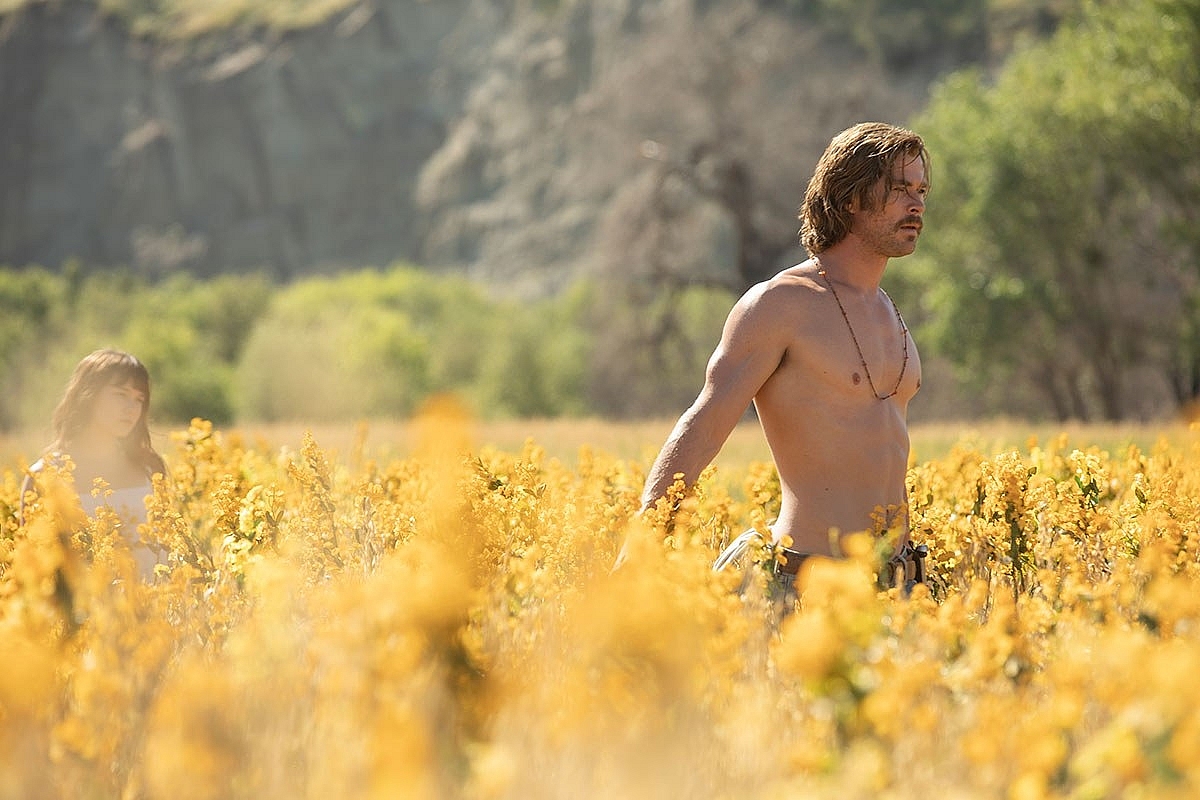
Dakota Johnson and Chris Hemsworth star in Twentieth Century Fox's "Bad Times at the El Royale." Photo by John P. Johnson. Copyright: © 2018 Twentieth Century Fox Film Corp.
Whilst this interior/exterior stage build was a fairly unusual circumstance, McGarvey says it provided him with huge degree of photographic control. Indeed, for the big reveal in the movie, McGarvey was able to make the most of this environment to create a continuous-take, lasting over five minutes, which has become somewhat of a trademark, the DP having devised similar shots in Atonement (2007) and Life (2017, dir. Daniel Espinosa).
Production also encompassed a daytime shoot of the hotel exterior, built nearby, although this entailed a bitterly cold day of filming after ice and snow covering the set had been physically melted away. Shoots for the flashback sequences took place at a local farm, at various locations on the Californian coast, north of Malibu, and at the Polsa Rosa Movie Ranch.
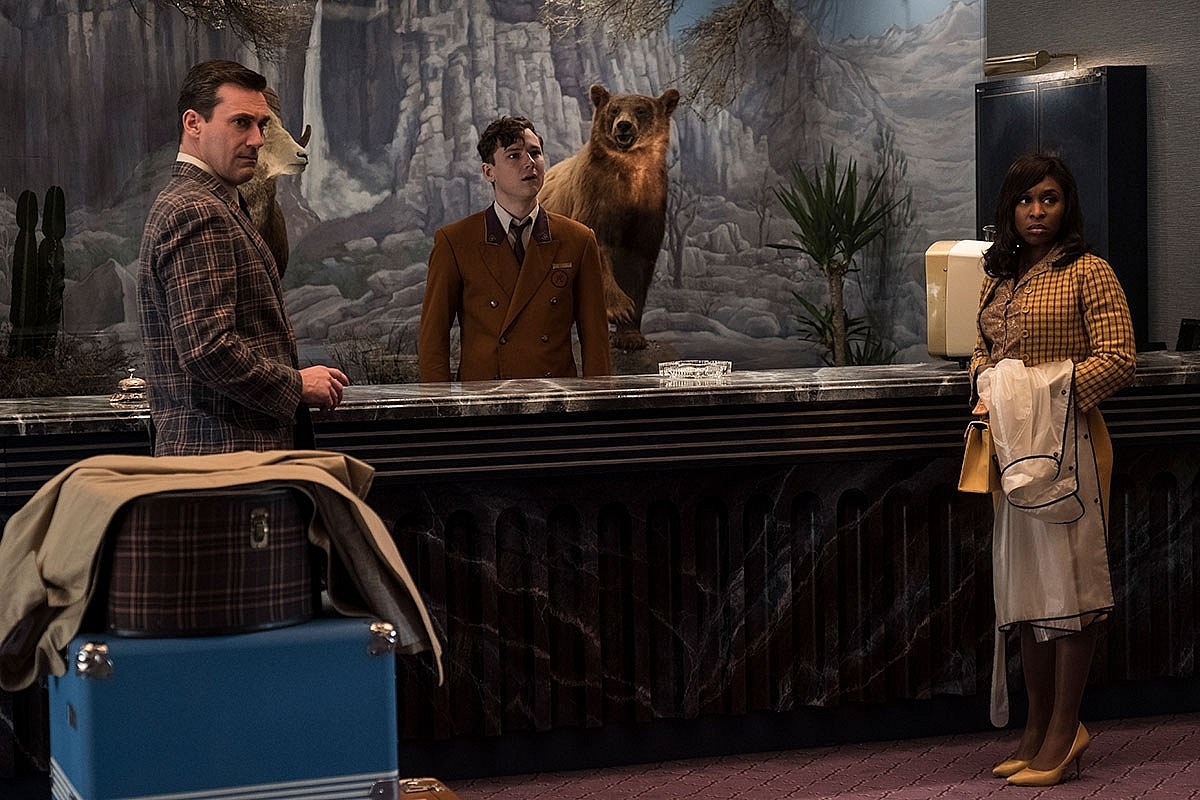
L-r, Jon Hamm, Lewis Pullman and Cynthia Erivo star in Twentieth Century Fox's "Bad Times at the El Royale." Photo by Kimberley French. Copyright: © 2018 Twentieth Century Fox Film Corp.
Ron Prince caught up with McGarvey to discover more about his work on the movie, as the cinematographer was about to complete the DI grade at Technicolor in Los Angeles, with senior colourist Steve Scott.
So how did you come to get involved with Bad Times at the El Royale?
SM: I was actually working on The Greatest Showman (2017, dir. Michael Gracey) in New York, when one of the executives from Fox showed me the script. It was one of those un-put-down-able scripts that you read in one go, from cover-to-cover. I knew Drew a little, having met him briefly when he came on-set of The Avengers (2012, dir. Joss Whedon) as he’s a good friend of Joss’. I was already an admirer of Drew’s screenplays on productions like Cloverfield (2008, DP Michael Bonvillain), The Cabin in the Woods (2012, DP Peter Deming ASC) and The Martian (2015, Dariusz Wolski ASC), and I was really impressed by Bad Times at the El Royale. Also, there’s nothing like working on a job, and getting the prospect of your next one!
What were you early conversations with Drew about the look of the film?
SM: Our first conversations were on Skype, whilst I was still on The Greatest Showman, and that’s when I was offered the job. When I wrapped, I went out to LA to discuss things it in more detail with him. He had very clear and exciting ideas about the set and costume design, and how he wanted to distinguish the compendium of strong, singular characters and their identities, through colour coding. For example, Cynthia Erivo who plays the singer Dolores was to appear in purple. The priest, played by Jeff Bridges, was B&W. Others were red and pink, and so forth. If there was an analogy I would liken it to Cluedo. However, Drew was concerned that such strong characterisation and bold visualisation might appear operatic, vaudevillian or even camp, and he didn’t want the artifice to divorce the audience from the story.
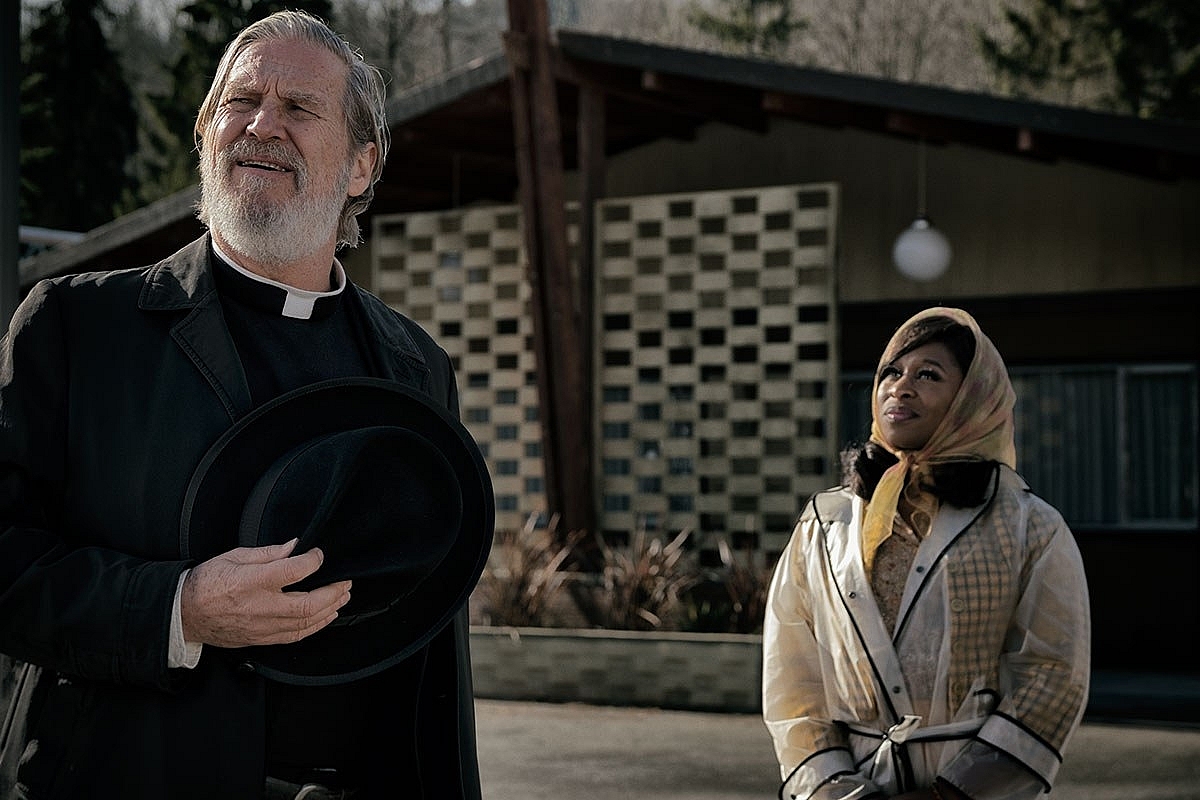
Jeff Bridges and Cynthia Erivo star in Twentieth Century Fox's "Bad Times at the El Royale." Photo by Kimberley French. Copyright: © 2018 Twentieth Century Fox Film Corp.
Did you consider any references in helping you to achieve the look?
SM: Yes, we found inspiration in a number of films. One of the big ones we discussed was Francis Ford Coppola’s One from the Heart (1982, DPs Vittorio Storaro/Ronald Víctor García) to explore the notion of shooting day and night exteriors on an indoor studio set, use of colour, and to absorb its cinematic feel.
We also looked at Klute (1971, dir. Alan J Pakula, DP Gordon Willis ASC) one of my all-time favourite movies, where the cinematography starts off airy and sunny before gradually descending into a noir-esque obscurity of darkness and shadows, defiantly using the edges of the frame.
The Coen Brothers have a wonderful way of gently stylising situations, and there’s no better example than Barton Fink (1991, DP Roger Deakins CBE BSC ASC). They had a tight grip on how much they used that stylisation, in terms of mise en scène and tuned-up cinematography, to the point that it’s believable and not hammy. So it was quite an inspirational reference in terms of addressing Drew’s concerns about things getting too histrionic.
Drew kept saying to me that it was a very Catholic film. The script has a lot of Biblical tonalities and references. It’s a struggle between good and evil, honesty and lies, life and death, love and hate –things that happen in the Bible and in faith, all syphoned down into a super-charged drama. Along with suggestions of God and cruciform imagery in the design cues, there’s even a deluge and a fiery finale.
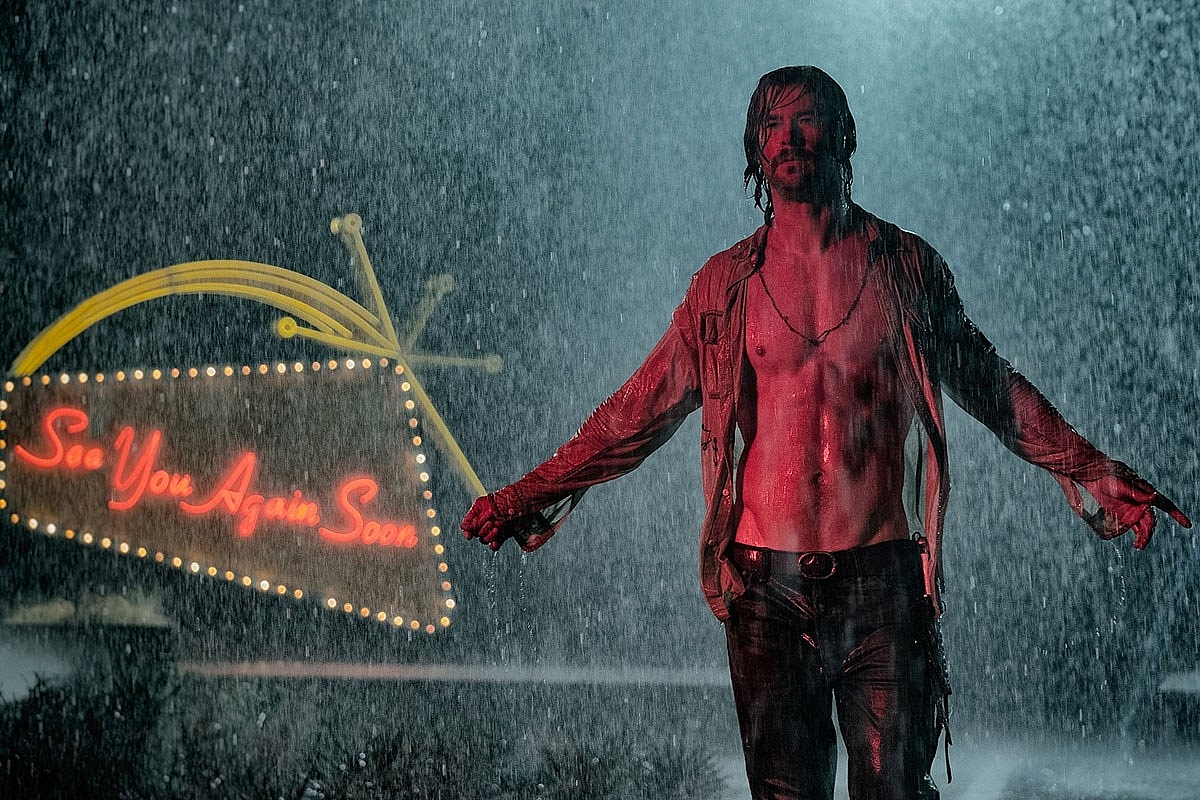
Chris Hemsworth stars in Twentieth Century Fox's "Bad Times at the El Royale." Photo by Kimberley French. Copyright: © 2018 Twentieth Century Fox Film Corp.
Who were your key collaborators and crew?
SM: I worked closely with Martin Whist, the production designer, and Danny Glicker the costume designer – and their work was exquisitely detailed and fabulous to light. Joel Whist was the SFX supervisor, who did a wonderful job with the rain rig and all the complex fire work we shot at the climax of the film.
As for my crew, Dave Emmerichs was on A-camera, with 1st AC Doug Lavender and 2nd AC Rodrigo Carcamo, Steve Krasznai was on B-camera, supported by 1st AC David Lourie and 2nd AC Dan Robinson. Our loader was Adriene Wyse and the camera trainee was Luze Rubio. Peter Wilkie headed-up our second unit, with producer with Jeremy Latcham. My gaffer was Stuart Hegarty, and the key grip was Mike Kirilenko.
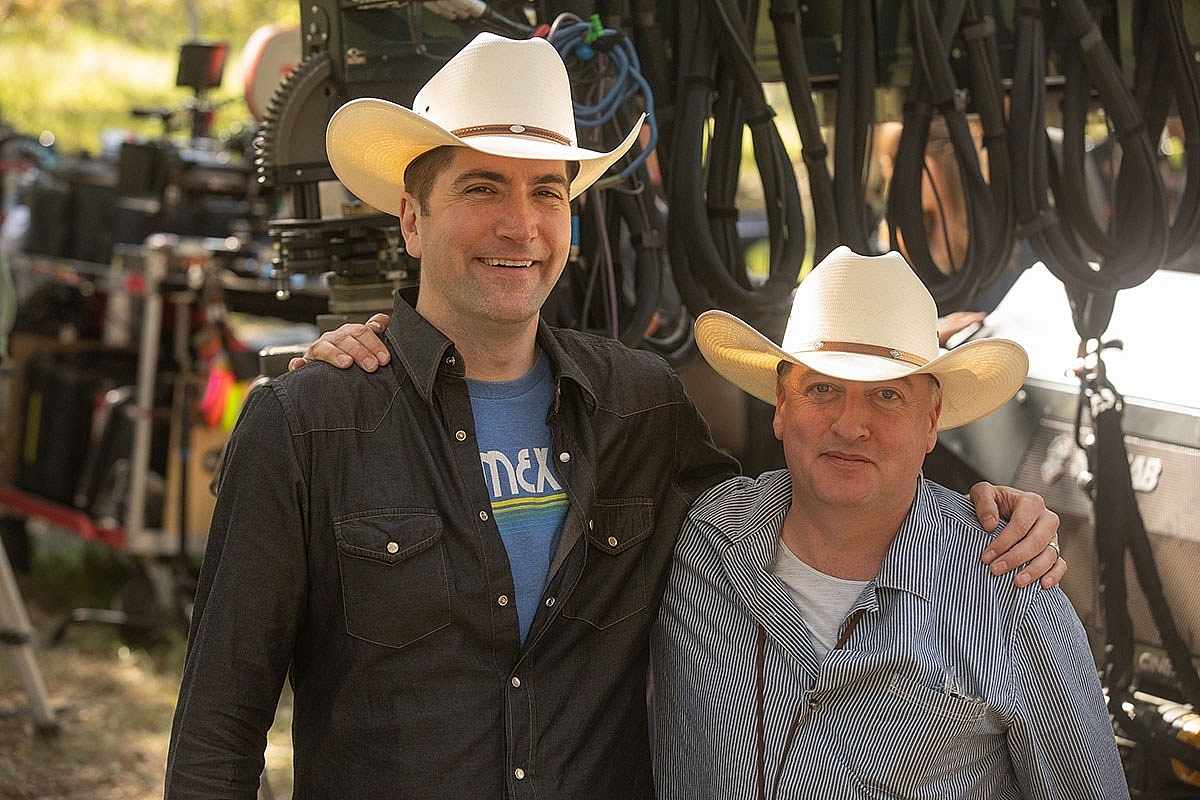
Director Drew Goddard, left, and cinematographer Seamus McGarvey BSC ASC, on the set of Twentieth Century Fox's "Bad Times at the El Royale." Photo by John P. Johnson. Copyright: © 2018 Twentieth Century Fox Film Corp.
What cameras and lenses did you choose?
SM: Both Drew and I always saw Bad Times at the El Royale as a widescreen Anamorphic production. I went with Panavision C-series Anamorphics, plus 135mm and 180mm E-series, I love their beautiful inherent deficiencies – the focus fall-off at the edges, and the bend in the wider lenses. Doug, my 1st AC, went to Panavision in LA, selected a set and had them tuned by Dan Sasaki. We were fortunate to get them, as they are extremely popular. You can pick where the lenses sing in certain scenarios, and we wanted more clarity on the upper edges of the frame, to minimise the distortion on some of the wider lenses, and to tighten-up the close focus on some of the longer lenses. During production, the favourites turned out to be the 40mm and 75mm lenses, and occasionally the 135mm E-series. We shot the entire film on Prime lenses. The Panaflex XL is my go-to, as it’s a great compact camera and can be easily rigged for different shooting modes. We generally had two cameras on the production, and shot between T2.8 to T4, but the first ACs did a great job of keeping the shots crisp even at these stops.
I must mention that Martin Whist designed the sets with 2.40:1 perspectives and compositions in mind, and it was like butter – so easy to make great compositions wherever you looked.
What are you thoughts about the value of shooting on film in this day and age?
SM: Film is for life. It is the medium of cinema, and always has been. I am delighted that Kodak is going strong, giving filmmakers the option of using celluloid. First and foremost, I love the look of film, but I enjoy the rigour and discipline that comes with using it too. It’s also an act of faith. There’s an unknown in the alchemy of it all, but it’s always full of positive surprises. Perhaps that is what Drew meant when he said it was a Catholic film!
Film is worth its weight in gold, well silver actually, in creating engaging visual images. I think film will continue to endure, as audiences love the look and studio producers seem to be happy with the numbers.
Which filmstocks did you select and why?
SM: I shot the entire production on KODAK VISION3 500T (5219). It’s incredibly versatile and I knew one size would fit all. As most of the film takes place at night, and we would be regularly shooting on dark sets, I knew I would need a fast stock. So the 500T was the obvious choice. To save on the short-ends, I decided to shoot all of the daytime and exteriors with the 500T too, using NDs to help the control the exposure, plus an 85 filter to apply the correction in-camera. I prefer to correct during the shoot, as when you correct in the DI the look of the greens can be too rich for my liking. We shot a lot of film, nearly one million feet, and the fingers of our dedicated loader, Adriene Wyse, were on fire with all of the loading of the magazines!
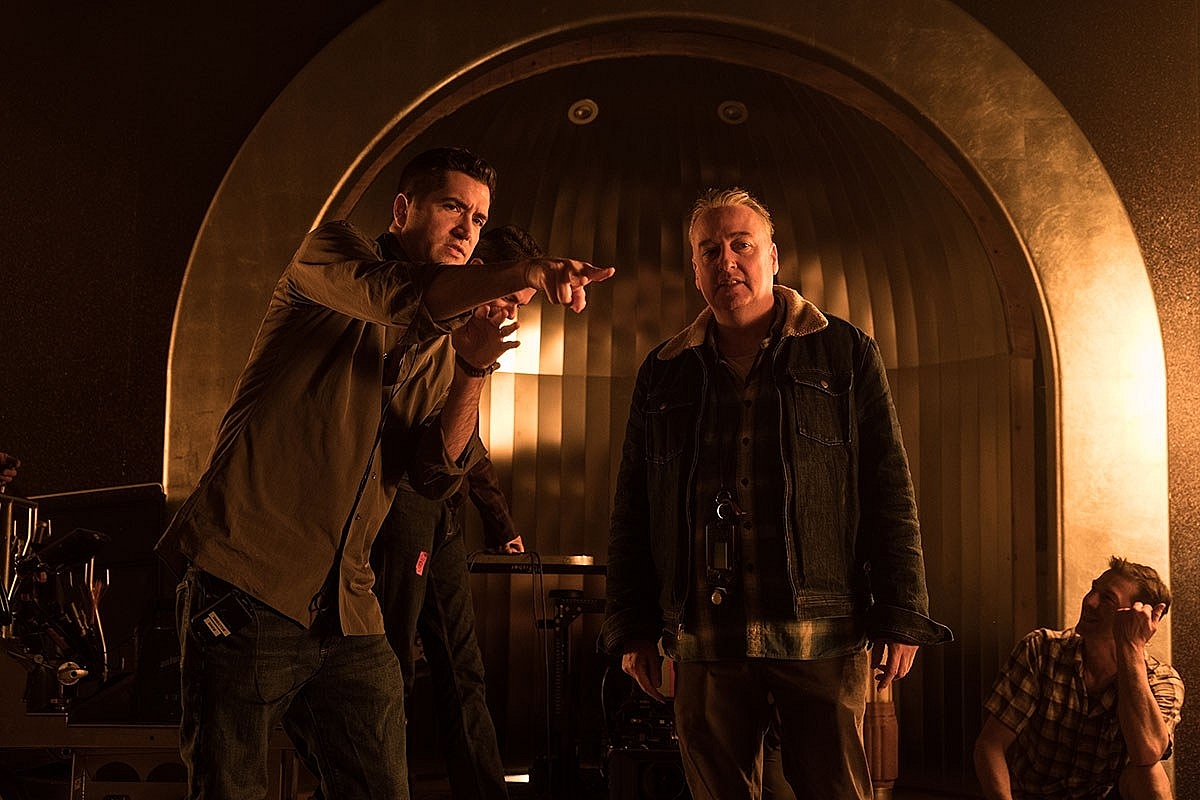
Director Drew Goddard, left, with cinematographer Seamus McGarvey BSC ASC, on the set of Twentieth Century Fox's "Bad Times at the El Royale." Photo by Kimberley French. Copyright: © 2018 Twentieth Century Fox Film Corp.
Although the 500T is high-speed, it has wonderful range and latitude. You can let highlights bloom, and burn-out a backlight, and still be confident of having detail in that part of the image. We shot on a sunlit beach near Malibu, where the water was glittering and glistening. That would probably have choked a digital sensor, but look on film has wonderful lustre and opalescence. Plus, the 500T has grain too, which is just beautiful to behold.
But it’s the way Kodak film responds to colour that I particularly love, and in this case its gentle, faithful registering of red, which is recurrent in the movie. Even the latest digital cameras have not yet got that sorted, but on film red is gorgeous, translucent and alive. Also, on sequences involving fires, I could not have properly registered the correct shape, nor the colour, of the flames on digital, but on film the results look spectacular.
Where did you get your rushes processed?
SM: We used Fotokem to process the negative, who did a great job for me once again. The 2K dailies were scanned at Technicolor in LA, under the supervision of dailies colourist Erik Haase. I worked with Erik on Nocturnal Animals and he did such a great job again for us.
What was your approach to the camera movement?
SM: We did quite a lot of kinetic camera moves during the first third of the movie, when the skies are blue. The camera has brio, verve and travel, which we achieved using the dolly and a Technocrane and occasionally Steadicam. But as the sun goes away and the rain starts to pour, the camera movement becomes diminished, and gradually devolves to bold static frames to capture the drama.
Can you give us some details about the long, continuous shot you created?
SM: Ah yes, that extended shot – when Jon Hamm’s character discovers the secret mirrored corridor behind the hotel bedrooms – was quite a challenge. I originally thought we might do it with a long track and a Technocrane, as I wanted the camera perspective to be solid and travelling decisively but without the float or the shifting horizon, that sense of another person being there, that you often get with Steadicam. But having done a TechViz of the scene, I realised the Technocrane move would have dictated how the actors would perform and move.
I was fortunate to have one the greatest grips in the world, Ryan Monroe, who suggested we do the shot on the dolly, using a remote Libra head, which Dave Emmerichs operated. To avoid reflections on the two-way glass, we dressed in black, and sprayed a hide-like cover with non-reflective paint, and put that over the dolly, which we called ‘The Glory Hole’. Only the lens protruded.
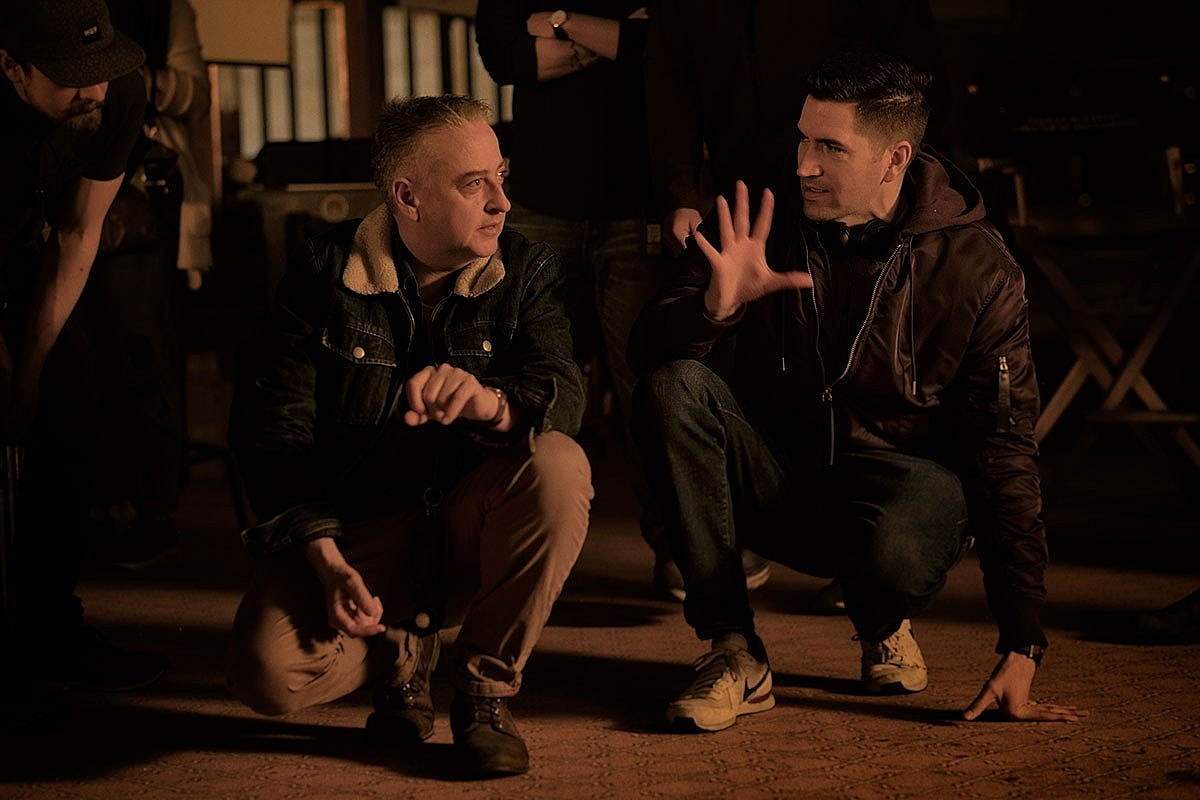
Cinematographer Seamus McGarvey BSC ASC, left, and director Drew Goddard, on the set of Twentieth Century Fox's "Bad Times at the El Royale." Photo by Kimberley French. Copyright: © 2018 Twentieth Century Fox Film Corp.
Ryan is such a sensitive mover, a virtuoso, perfectly in-tune with the vagaries and surprises of an actor’s timing. The move was pretty elaborate, moving back and forth along the corridor, and in 360 degrees. Plus we had lights being lowered up-and-down, in-and-out, as well as a floating wall, and live singing throughout from Cynthia Erivo in one of the rooms. It became quite a dance between the camera, lights and the actor. We spent half a day rehearsing the move and the best part of a day shooting it. It was an immense relief when we got it, and a feeling of great achievement.
How about your lighting plans?
SM: Stuart Hegarty, my gaffer, with whom I worked on Godzilla (2014) and 50 Shades Of Grey (2015), was superb once again, and developed some of the best lighting plans I have ever seen. The illumination was all about the colour and being able to change between scenes and sequences pretty quickly. We used a huge number of ARRI SkyPanels rigged above silks during daylight takes, although the silks, and some of the lights, were removed to make way for the rain heads. We left the remaining lights for moonlight ambience. The beauty of working with the SkyPanels is that you can go from daylight to moonlight colour in an instant on the remote control pad.
LEDs came into their own for me on this film. For example, there’s a beautiful Würlitzer jukebox in the hotel, however its built in lighting was crude and not bright enough. So we rigged it with amazing LEDs, which we could wrap around various parts of the Juke Box and cue to the music with different colours and travel of the light.
There are some spectacular moments, such as when Chris Hemsworth’s character appears in bloodshot red during the almighty tempest. I enjoyed flooding him and the neon El Royale hotel sign with banks of red-hued SkyPanels, supplemented by T12 sources gelled with primary red. Generally, though we let the colours of the characters come from the set painting, wall surfaces and costume design, rather than coloured illumination. Similarly, we decided not to photographically treat the flashback sequences, and let the sets, wardrobe and change of scenario to take us back.
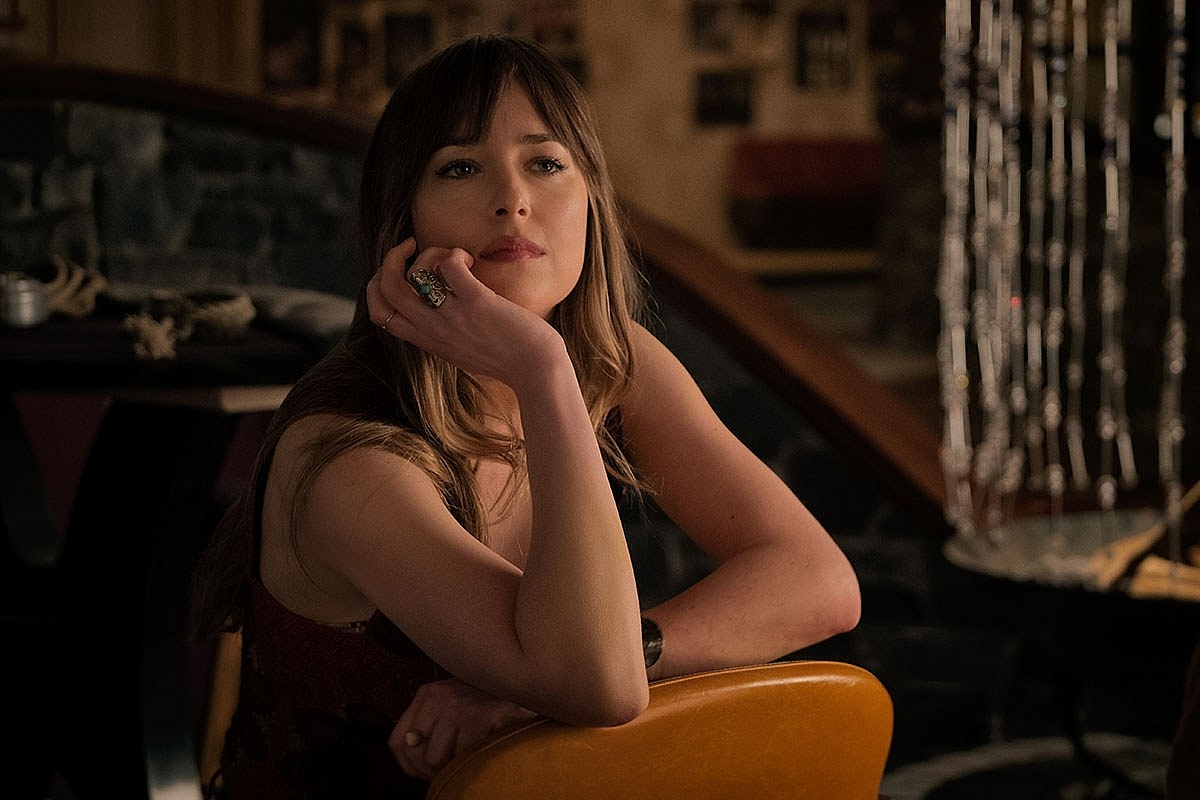
Dakota Johnson stars in Twentieth Century Fox's "Bad Times at the El Royale." Photo by Kimberley French. Copyright: © 2018 Twentieth Century Fox Film Corp.
What can you tell us about the DI?
SM: This film is my sixth film with Steve Scott, and he is an artist in the DI suite. I love working with him. He has such a great eye for colour and for naturalism, but is also unafraid of making bold choices when the film needs it.
Please explain the level of control you had by shooting the exteriors in the studio?
SM: One of the advantages of shooting inside the studio was the weather. We were shooting in the winter, in -20ºC and therefore could not create rain, nor shoot, outside. Shooting inside the studio meant I could really control the light with the ever-worsening downpour. The rain starts softly to begin with and gradually becomes an unholy deluge. We had a big rig of Sky Panels and Arri T12 lights on cherry pickers to backlight the rain as it changed through the production.
There was also quite a long scene of a huge bonfire burning at night in the forest, that we shot inside, with a giant vent above to extract the smoke. It would have taken three nights in the blistering cold to have shot that, and there were naked people in that scene. But the great advantage was that we shot that during the daytime, and we didn't get frozen.
So is Bad Times at the El Royale your best work so far?
SM: I always try to extend myself and try something new with every film. This one was one of the most creative and happy times I have ever had on a film. Shooting on 35mm film, working with such an imaginative director as Drew, on a story containing such strong cinematographic sensibilities, was a great privilege, and I am delighted with the result.